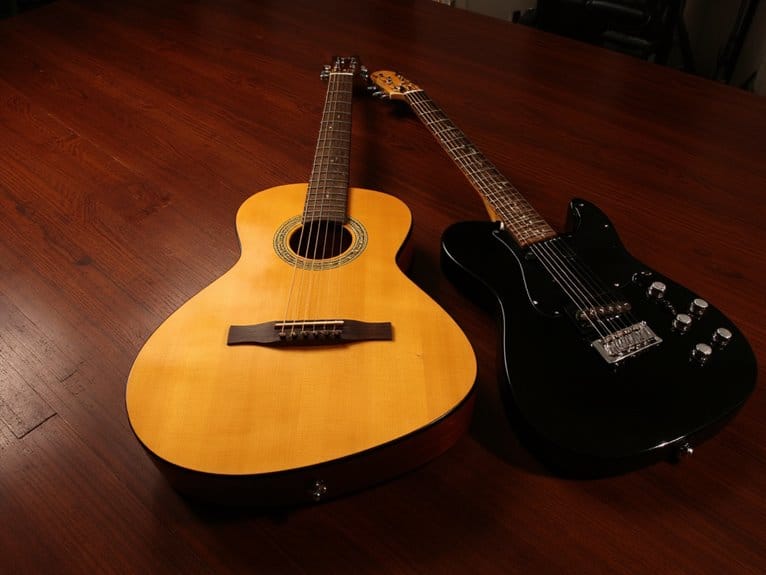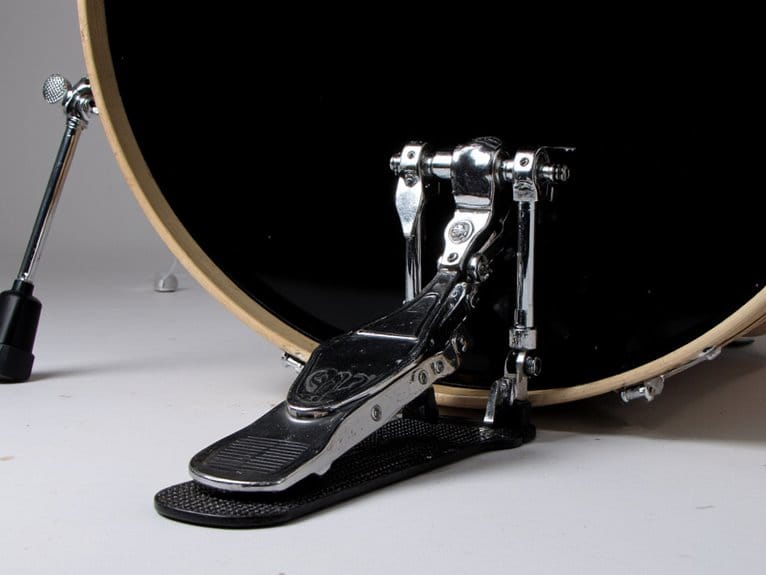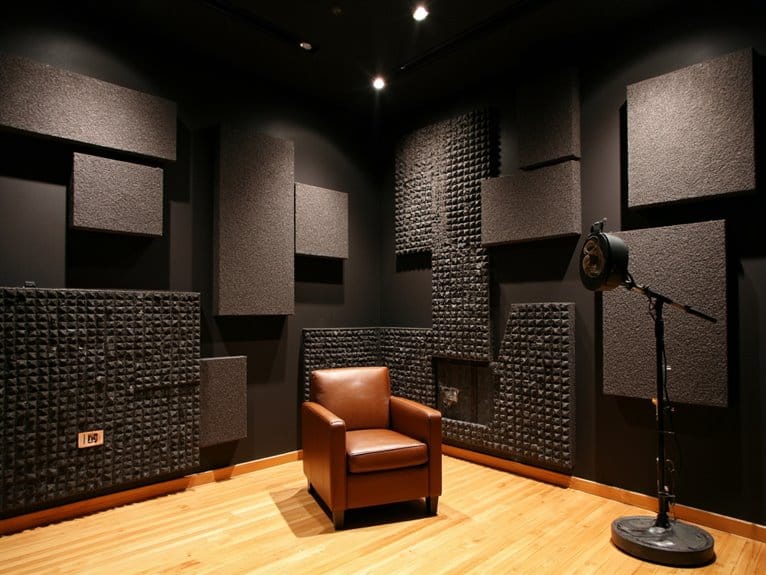When to Replace Heads on Acoustic Drum Sets
You’ll need to replace your drum heads when they show visible cracks, permanent dents, or won’t hold tuning properly, which typically occurs every 3-6 months for regular players. Beginners can stretch this to six months with light use, while advanced drummers should replace heads every 2-3 months to maintain professional sound quality. Batter heads wear faster than resonant heads due to direct stick contact, and factors like playing style, humidity, and storage conditions greatly impact longevity-though there’s much more to reflect on about maximizing their lifespan.
We are supported by our audience. When you purchase through links on our site, we may earn an affiliate commission, at no extra cost for you. Learn more.
Notable Insights
- Replace drum heads when you notice visible cracks, tears, holes, permanent dents, or wrinkles that affect sound quality.
- Beginners should replace heads every 6 months, intermediate players every 3-6 months, and advanced players every 2-3 months.
- Batter heads need more frequent replacement than resonant heads due to direct stick impact and wear.
- Heavy playing styles, frequent gigging, and harsh environmental conditions accelerate the need for drum head replacement.
- Replace heads immediately before important recordings or performances to ensure optimal tone and professional sound quality.
Replacement Timeline Guidelines for Different Playing Levels
Three distinct playing levels require dramatically different approaches to drum head replacement, and I’ve learned through years of teaching that understanding your skill level’s specific demands can save you both money and frustration.
Beginner practices typically involve lighter playing frequencies, allowing batter heads to last approximately six months under normal conditions, though you’ll want to monitor sound quality rather than strictly following calendars.
For beginners, prioritize sound quality over strict timelines when determining six-month drumhead replacement schedules.
Intermediate habits change everything-once you’re gigging regularly or practicing three to five times weekly, you’re looking at three to six-month replacement cycles for snare heads, while toms can stretch six to twelve months depending on your intensity. Snare drum heads may require replacement twice as often as tom heads due to different wear rates between drum types.
Advanced players often replace heads every two to three months, especially before recording sessions, since maintaining ideal tone becomes critical for professional performance standards. Environmental factors like humidity and temperature fluctuations can significantly impact head longevity regardless of your playing level.
Visual and Physical Warning Signs That Demand Attention
Your drumheads will telegraph their deteriorating condition through unmistakable visual and physical cues, and I’ve found that learning to read these warning signs prevents the embarrassing mid-song blowouts that every drummer experiences at least once in their career.
| Visual Damage | Performance Impact |
|---|---|
| Cracks or tears | Immediate replacement needed |
| Surface dents/pits | Compromised tone quality |
| Wrinkles/stretching | Tension loss, tuning issues |
| Holes near beater zone | Urgent safety concern |
| Permanent indentations | Material fatigue evident |
Visible damage represents the most obvious replacement indicator, while tonal degradation often precedes physical deterioration. When your heads lose their characteristic bounce, produce dead tones despite proper tuning, or require excessive tension adjustments, they’re communicating their declining structural integrity through diminished performance capabilities. Even without obvious physical damage, drummers should consider changing heads periodically to maintain optimal sound quality and prevent unexpected failures during performances. Coated heads typically show visible wear patterns more readily than their clear counterparts, making damage assessment more straightforward for drummers who prefer textured surfaces.
Key Factors That Impact Drum Head Durability
While replacing drumheads based on visible damage provides clear-cut decision points, understanding the underlying factors that accelerate or extend their lifespan empowers you to make more strategic replacement decisions and budget accordingly.
Your playing frequency greatly affects durability, with heavy gigging requiring replacement every two months compared to recreational use lasting six months. Different playing styles create varying wear patterns, as aggressive techniques and continuous rimshots accelerate material fatigue faster than controlled dynamics.
Environmental conditions considerably impact performance, since humidity fluctuations and temperature shifts compromise tension stability and weaken drum head materials over time. Double-ply heads offer superior longevity compared to single-ply options, while proper storage in controlled climates prevents premature degradation from heat exposure and moisture. Using appropriate sticks and proper striking technique helps minimize unnecessary stress on the drum head surface. The musical genre you play significantly influences drumhead wear, as aggressive styles like rock or metal create more stress than jazz or folk music. Recording sessions with dynamic microphones positioned close to drum heads can also influence your replacement timing, as these setups reveal subtle changes in drum tone that may not be noticeable during live performances.
Understanding the Difference Between Batter and Resonant Head Replacement
Two distinct drumheads work together to create your drum’s complete sound, yet they serve fundamentally different roles that dictate unique replacement strategies and timing considerations.
Your batter head, which endures direct stick impact, requires more frequent replacement due to physical wear, dents, and thinning that affects batter head dynamics like attack and responsiveness.
Batter heads endure constant stick punishment, developing wear patterns and tonal degradation that demand more frequent replacement than their resonant counterparts.
I’ve found that resonant heads last considerably longer since they’re not directly struck, but they’re equally essential for sustain and harmonic balance.
When resonant head nuances start deteriorating-think muffled overtones or diminished sustain-replacement becomes necessary even without visible damage.
The key difference lies in replacement frequency: batter heads demand attention based on durability concerns, while resonant heads typically need changing when tonal quality degrades or you’re seeking different acoustic characteristics. Minor variations in thickness and type can substantially alter overall sound, making replacement timing crucial for maintaining your desired tonal profile. Higher resonant head tuning produces more stick rebound, which directly impacts your playing experience and technique requirements.
Maintenance Strategies to Maximize Drum Head Lifespan
Since proper maintenance can easily double your drum head lifespan while preserving ideal sound quality, I’ve developed a thorough approach that focuses on four critical areas: consistent cleaning routines, precise tuning practices, mindful playing techniques, and strategic environmental management.
My cleaning techniques center on wiping heads after each session with slightly damp cloths, avoiding harsh cleaners that damage coatings. For tuning tips, I maintain even tension across all rods, preventing warping and premature stretching that shortens head life. Using microfiber cloths for cleaning provides optimal results without scratching or damaging the drumhead surface.
| Maintenance Area | Key Practice |
|---|---|
| Cleaning | Wipe with damp cloth after use |
| Tuning | Even tension across all rods |
| Storage | Use dust covers, avoid heat sources |
Regular inspection reveals wear patterns early, while proper stick selection and controlled playing dynamics distribute impact forces evenly, considerably extending replacement intervals. Additionally, I always tune rods in a star pattern to maintain consistent tension distribution, which prevents uneven stress points that can cause premature head failure.
On a final note
You’ll know it’s time to replace your drum heads when visual wear, tonal degradation, or playing frequency demands it. I’ve learned that batter heads typically need replacement more often than resonant heads, though both contribute to your overall sound quality. By monitoring dents, stretching, and frequency response changes, you’ll maintain peak performance while maximizing your investment. Regular cleaning and proper tensioning techniques will extend head lifespan, but don’t compromise your sound for economy.






